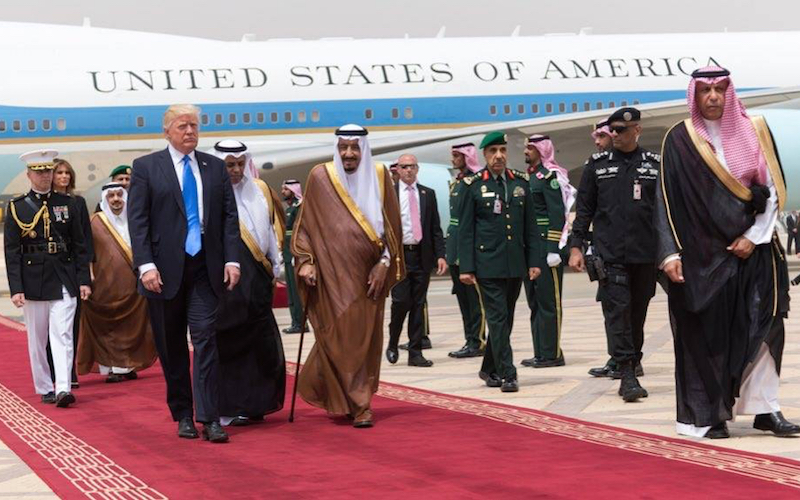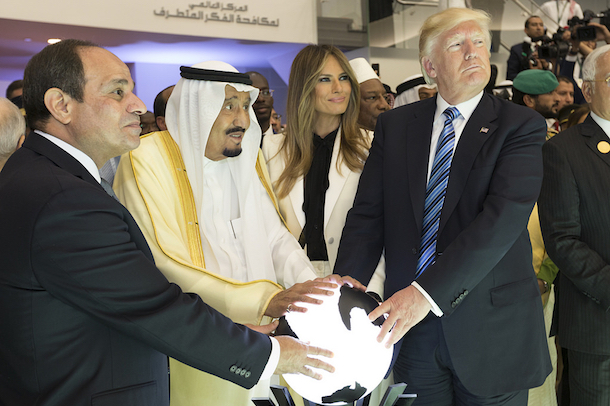
Trump Addresses the Muslim World on Fighting Extremism
Many would describe President Trump’s visit to Saudi Arabia as one that reflected a ‘double standard’ in regards to the issues of human rights and democracy. President Donald Trump has already drawn some serious criticism from human rights groups for his trip to Riyadh, in one of the world’s most repressive nations when it comes to advocacy groups.
President Trump addressed the over 50 predominately Muslim nations at the Arab-Islamic American Summit in Riyadh and urged them to “Drive them [the terrorists] out of your places of worship.” In addition, President Trump gave a very powerful description of terrorism and called the terrorists actions, “an insult to every person of faith. Terrorists do not worship God. They worship death.” Trump’s analysis of driving the terrorists out is that extremism is a religious problem that has taken over mosques and madrassas, but not only that, extremism has also taken over Islam itself.
President Trump was presidential, he was positive, and he did not speak about the rhetoric that came out of his presidential campaign in his address to the Arab leaders, but he still left a huge gap in the realities that are plaguing the region on the ground. However, there was an irony in President Trump’s speech. This irony refers to the Wahhabi ideology that continues to spread throughout the Middle East and the rest of the world. Saudi Arabia is one of the world’s leading exporters of terrorism and the Wahhabi ideology did originate in the Saudi kingdom during the 18th century.
According to well-known English journalist and writer Robert Fisk President Trump completely ignored “the fact that Saudi Arabia, not Iran, is the fountainhead of the very Wahhabi Salafist extremism whose ‘terrorists’ murder ‘innocent people.’ U.S and Saudi officials are trying to portray Trump’s visit to Riyadh as historic, and many say that the United States wants good ties with the Saudis.
On Saturday, the United States and the Kingdom of Saudi Arabia signed an arms agreement of up to $110 billion under which Washington will continue to sell state-of-the-art weaponry to the Saudi Kingdom in their fight against extremism. The Saudi government has carried out a devastating, catastrophic war in Yemen, one of the world’s poorest countries in terms of Gross-Domestic Product (GDP), they have contributed to funding the crisis in Syria, and they are facing a growing crisis in Bahrain. In fact, another irony during the visit was that the KSA had welcomed a president who accused Saudi Arabia for their involvement in the 9/11 attacks in 2001, “It wasn’t the Iraqis, it was Saudi — take a look at Saudi Arabia, open the documents.” President Trump described his trip to Saudi Arabia as a tremendous trip and a great investment opportunity for the United States to maintain stability in accordance with the post-1945 relationship.
The ‘Blind Eye’ to Reality
During the presidential campaign, President Trump took different stances on his Middle East agenda than his predecessor Barack Obama. President Trump de-emphasized democratization and human rights. However, the arms sales has not made the Middle East stable, but these sales have made the situation a lot worse when it comes to the casualties of innocent civilians and the overlapping geopolitical interests in the region. The United States has been selling arms to Saudi Arabia for a long time by both Republican and Democratic presidents, but this reflects the view of President Trump not getting involved in other country’s affairs. Saudi Arabia is not necessarily the first country any U.S president would visit out of all the countries in the world, and Trump’s words and his unpredictable behavior are not very good guardians to any drastic change in the Middle East.

Saudi Arabia was a country that was criticized by President Trump during his presidential campaign as being a repressive state and being possibly tied to the 9/11 attacks. This is a remarkable shift for the U.S and sometimes money and arms sales can be good for security, but this can go backwards, forwards, or upside down. The United States and the Saudis have been responsible for the repression in Yemen, the repression in Iraq and Syria, and even the attacks in Al-Awamiyah, a predominately Shia area in the Eastern Province of Saudi Arabia. Unfortunately, the money and the weapons will continue to contribute to these atrocities and this will also continue to strengthen the repression of innocent civilians.
Making America Great Again?
15 of the 19 hijackers of the 9/11 attacks were allegedly Saudi citizens and by not pressuring Riyadh to stop the breeding of terrorism, President Trump has not really met the interests of the American people and the families of the 9/11 victims.
President Trump’s number one foreign policy priority is to defeat DAESH, and his purpose is to rally the Muslim world in the fight against extremism. The irony is that President Trump is discussing this with the Saudi government, which many experts say is one of the largest exporters of DAESH troops and wealth in the Middle East. There is no doubt that the Saudi government has supported Wahhabism, which has been the intellectual foundation for Sunni extremism, and there is also no doubt that Saudi Arabia and Turkey have been supporting Sunni extremists in Syria.
Before 9/11 Osama bin Laden purposely recruited Saudi citizens to implicate Saudi Arabia as a supporter for terrorist groups, but in fairness to the KSA, in some ways, they have been a strategic partner for the United States and there has been constructive cooperation between Riyadh and Washington. If Saudi Arabia pulled the plug on money and arms to Sunni extremists in the region and around the world, we would see a more peaceful Middle East. It is also astonishing for President Trump to go to Saudi Arabia and not criticize the Saudis for what they have done and said about extremism, while at the same time, denounce Iran being a sponsor for destabilization in the region as a mastermind of terrorist networks.
Red Lines on Iran
President Trump criticized Tehran for its support of the Syrian government and for what he calls support for terrorism. Of course, presidential candidate Donald Trump had said that it was the Russians, Iranians, and the Syrians who were in actuality fighting extremism and if Washington really wanted to stop extremism, it should be allied with them to defeat it. President Trump has done a complete 180, from what he said during the campaign to his first 100 days in office. So far into his presidency, Trump has yet to be a strategist. Trump has been described as a counterpuncher and a president who trusts his instincts, but it is so hard to explain the rationale behind his grand strategy.
During his speech in Riyadh, Trump called out Iran for its destabilizing role in the region, and called the Islamic Republic this threat “that gives terrorists all three—safe harbor, financial backing, and the social standing needed for recruitment. It is a regime that is responsible for so much instability in the region. I am speaking of course of Iran.” President Trump also blamed Iran for the sectarianism going on in the Middle East “From Lebanon to Iraq to Yemen, Iran funds, arms, and trains terrorists, militias, and other extremist groups that spread destruction and chaos across the region.”
It is pretty clear to see what side President Trump is on and he is trying to rally the Sunni nations to create a Sunni bloc that will counter Iran’s influence and its dreams for Shia hegemony in the region. However, the terrorism we are seeing throughout the region did not originate in Iran, even though there are Shia militia groups funded by Iran throughout Iraq and Syria. The ideology of Wahhabism is the most potent problem to the woes of the Arab countries. In addition, President Trump never really mentioned the origins of Wahhabism and how we can change the conditions of terrorists who feel brainwashed and marginalized in their own communities.
Maintaining the Status Quo?
The status quo, as it is right now in the Middle East, is not going to work and the U.S government needs to realize that drastic changes need to be made in order to achieve peace and stability. The Saudis continue to fight on all fronts, from their southern border in Yemen against the Houthi rebels, to the ongoing unrest of the Shia majority population over the Sunni Al Khalifa family in Bahrain, and the dangerous DAESH threat coming from Iraq and Syria. Saudi Arabia, geopolitically speaking is in a very dangerous situation. The U.S needs Saudi Arabia as a geostrategic ally, but at the same time, it must pressure the Saudis to gradually change their own terrorist problem inside Saudi Arabia and stop the funding to mosques and madrassas, stop the recruitment and training centers for terrorist fighters, and change their stance on human rights into something that is more modern that can correspond with Islamic values. Combatting extremism must start at home for the Saudis, and the arms sales will only make things worse in an already complicated region that has seen so much violence, so much sectarianism, and so much destruction.
The United States must also launch new negotiations with the Iranians who have pushed for liberal and modern reforms with the re-election of President Hasan Rouhani to work together on fighting extremism, but the U.S can also pressure the Saudis to come to the table in this regard, despite the Sunni-Shia divide. So far, given the attitude of the Trump administration, the status quo will continue until something dramatically changes in U.S foreign policy.

